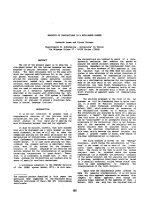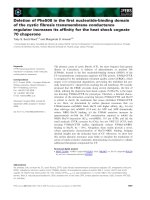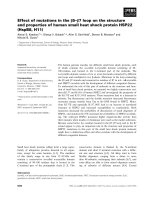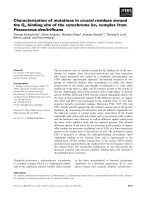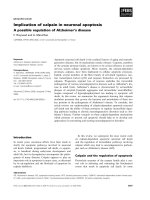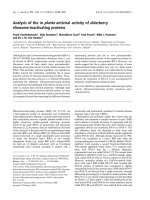Báo cáo khoa học: "Modification of pharmacokinetics of cefotaxime in uranyl nitrate-induced renal damage in black bengal goats" pps
Bạn đang xem bản rút gọn của tài liệu. Xem và tải ngay bản đầy đủ của tài liệu tại đây (46.51 KB, 3 trang )
-2851$/ 2)
9H W H U L Q D U \
6FLHQFH
J. Vet. Sci.
(2004),
/
5
(1), 1–3
Modification of pharmacokinetics of cefotaxime in uranyl nitrate-induced
renal damage in black bengal goats
Biswa Priya Dutta, Shiben Chandra Debnath, Tapan Kumar Mandal* and Animesh Kumar Chakraborty
Department of Pharmacology and Toxicology, Faculty of Veterinary & Animal Sciences,
West Bengal University of Animal and Fishery Sciences, Mohanpur, Nadia, 741252, West Bengal, India
Pharmacokinetics of cefotaxime (50 mg/kg, i.m.) were
studied in both healthy and kidney damaged female black
Bengal goats. Uranyl nitrate (0.75 mg/kg) was administered
intravenously, once daily for five consecutive days to induce
kidney damage. The pharmacokinetic variables were
calculated in both cases. Kidney damage caused several
changes in the determined variables. The C
max
and C
min
of
cefotaxime observed at 0.50 and 5 h in normal goats were
24.91 ± 1.51 and 1.22 ± 0.07
µ
g/ml, respectively, while the
same in kidney damaged goats at 1 and 72 h were 75.00
± 0.45 and 3.10 ± 0.09
µ
g/ml, respectively. Renal damage
condition significantly increased t
1/2,ka
(0.48 ± 0.01 h), t
1/2,ke
(20.03 ± 0.16 h), AUC (2440.10 ± 24.26
µ
g. h/ml) and
significantly decreased Vd
area
(0.59±0.007L/kg), V
ss
(0.58 ±
0.007 L/kg) and Cl
B
(0.02 ± 0.008 L/kg/h) values of
cefotaxime compared to normal goats.
Key words:
pharmacokinetics, cefotaxime, kidney damage,
goats
Introduction
Cefotaxime, a third generation cephalosporin derivative,
possesses a wide range of anti-microbial activity against
both gram positive and gram negative bacteria, and thereby
claims superiority over many other antibiotics. It is
extensively used in animals for treating systemic infection
like pyelonephritis, embolic nephritis and nephrosis.
Though the reports of cefotaxime kinetics in healthy animals
are available [1] but the effects of cefotaxime on kinetics are
scarcely available in kidney damaged goats. Therefore, the
present study, investigates the alteration of disposition
kinetics of cefotaxime in healthy and kidney damaged goats
following single intramuscular administration.
Materials and Methods
Cefotaxime sodium was used as the test drug. All the
chemicals used for the experiment were obtained from E.
Merck (India), Loba Chemicals Ltd. (India) and Sigma
Chemical Co. (USA)
Six clinically healthy adult black Bengal female goats
weighing between 10-12 kg were utilized in this experiment.
The animals were kept in individual custom made stainless
steel cage (48''
×
48''
×
36'') in a temperature (22 ± 2
o
C)
controlled animal room having provision of artificial light.
They were acclimatized with the laboratory condition for 7
days. They were fed with balanced feed and water was
supplied
ad libitum.
The animals were dewormed with
levamisole at 7.5 mg/kg 30 days prior to the onset of study.
The lower part of the neck of each animal was shaved and
the jugular vein was exposed. The animals were kept
overnight fasting prior to the start of experiment. All
procedure involved in the study were approved by the
Animal Ethical Committee of West Bengal University of
Animal and Fishery Sciences.
Cefotaxime sodium dissolved in 5 ml of pyrogen free
distilled water was administered intramuscularly in the thigh
region at 50 mg/kg. The blood samples (2 ml each) were
collected from the left jugular vein separately in heparinized
test tubes at 0, 0.08, 0.16, 0.33, 0.50, 0.66, 1, 2, 3, 4, 5, 6, 8,
10 and 12 h of post drug administration.
Plasma was separated by centrifugation at 3000 rpm for
20 min and stored at 4
o
C in refrigerator. One ml plasma was
utilized for estimation of cefotaxime concentration.
After a period of rest for one month, uranyl nitrate crystals
dissolving in distilled water was administered at 0.75 mg/kg
once daily for five consecutive days by jugular veinipuncture
to induce kidney damage [2]. Intensity of damage was
ascertained by monitoring blood urea nitrogen and plasma
creatinine levels every 24 h starting from 0 h to 144 h (6
days).
Cefotaxime at 50 mg/kg was administered by deep
intramuscular route (thigh muscle) to each goat after 24 h of
last dosing of uranyl nitrate administration (6th day) and
*Corresponding author
Phone: +91-033-26846062; Fax: +91-033-25571986
E-mail:
2 Biswa Priya Dutta
et al.
blood samples (2 ml each) were collected from left jugular
vein at 0, 0.08, 0.16, 0.33, 0.50, 0.66, 1, 4, 8, 12, 24, 36, 48,
60, 72, and 84 h for estimation of cefotaxime.
Cefotaxime was estimated by the modified method
described by Jha
et al
. [3]. The final volume of each aliquot
in test tube was 4 ml containing 1ml plasma and 3 ml
isopropyl alcohol in 0.05% of glacial acetic acid. Each test
tube was shaken vigorously for 5 min, allowed to stand for 5
min and then centrifuged at 3000 rpm for 30 min. The
supernatant was collected and analyzed in the UV-Vis
spectrophotometer at 295 nm against blank prepared with
plasma collected at 0 h. Concentration of cefotaxime present
in each blood sample was then calculated from standard
curve prepared earlier and expressed as mg/ml. The
minimum sensitivity of this method was 1 mg/ml.
Blood urea nitrogen and plasma creatinine levels were
estimated colorimetrically [4].
Students
t
-test was applied to test the level of significance
in drug concentration and kinetic parameters in different
groups of animals.
Results
Mean plasma concentration of cefotaxime at different
time interval after single dose intramuscular administration
at 50 mg/kg in healthy goats has been incorporated in Fig. 1.
Cefotaxime could be detected in plasma of goats at 0.08 h
(19.17 ± 1.07
µ
g/ml) followed by increase in concentration
and achieved a maximum concentration (24.91 ± 1.51
µ
g/
ml) at 0.50 h and thereafter the concentration of drug started
to decline. The minimum concentration was recorded (1.22
±0.07
µ
g/ml) at 5 h post dosing (pd). The plasma
concentration of cefotaxime was below the detection level at
6 h pd.
The disposition kinetic parameters of cefotaxime in goats
after i.m. administration have been presented in Table 1.
Table 1 shows that the mean value of zero time plasma
concentration (C
0
) was found to be 56.13 ± 3.60
µ
g/ml. The
ka and ke values were 4.51 ± 0.27 and 0.68 ± 0.01 h
−
1
, on
the other hand t
1/2
,
ka
and t
1/2
,
ke
values were 0.16 ± 0.01 and
1.03 ± 0.02 h, respectively (Table 1). The Vd
area
, V
ss
and Vd
c
values were 1.33 ± 0.09, 1.23 ± 0.09 and 0.92 ± 0.06 L/kg,
respectively. The k
21
and k
el
values were 1.13 ± 0.13, 3.07 ±
0.13 and 0.99 ± 0.02 h
−
1
, respectively. The f
c
and T~P values
were 0.69 ± 0.01 and 0.46 ± 0.02.
Mean plasma concentration of cefotaxime at different
time intervals after single dose i.m. administration at 50 mg/
kg in kidney damaged goats were presented in Fig. 1.
Cefotaxime could be detected in the plasma of goats at 0.08
h (34.00 ± 0.58
µ
g/ml), which then gradually increased
along with time, attained the peak level at 1 h; almost
maintained a plateau till 24 h and then slowly declined till
72 h pd. The concentration of cefotaxime was minimum at
72 h (3.10 ± 0.09
µ
g/ml) pd, and could not be detected
thereafter. Cefotaxime persisted in blood of kidney damaged
goats for a longer period with higher concentration
compared to normal goats.
The kinetic parameters of cefotaxime in kidney damaged
goats after i.m. administration are shown in Table 1. Table 1
reveals that mean value of plasma concentration at zero time
(C
0
) was 139.77 ± 1.60
µ
g/ml. More than two and half-fold
increase of plasma concentration at zero time was observed
in kidney damaged goats compared to normal goats. The ka
and t
1/2,ka
values were 1.46 ± 0.03 h
−
1
and 0.48 ± 0.01 h,
respectively (Table 1). The lower ka along with higher t
1/2
,
ka
values indicated slow rate of absorption of drug in kidney
damaged goats compared to normal goats (ka, 4.51 ± 0.27
h
−
1
; t
1/2
,
ka
, 0.16 ± 0.008 h). The ke and t
1/2
,
ke
values were 0.04
± 0.001 h
−
1
and 20.03 ± 0.16 h, respectively. The ke values
was very poor while t
1/2
,
ke
value was twenty times larger than
that of normal goats. Likewise, Cl
B
and k
el
values were 0.02
± 0.008 L/kg/h and 0.06 ± 0.001 h
−
1
which were significantly
lower than that of the values of normal goats.
Discussion
The maximum concentration of cefotaxime was recorded
at 0.5 h following intramuscular administration to healthy
goats. Atef
et al
. [1] also reported a mean peak plasma level
of cefotaxime at 0.5 h after intramuscular injection in goats.
The t
1/2
,
ke
value of the present study was found to be higher
(1.03 ± 0.02 h) than that of reported by Atef
et al
. [1] (39
min) in healthy goats which might be attributed to different
climate and different varieties of goat. The lower body
clearance (Cl
B
) value might be the cause of persistent t
1/2
,
ke
in
the present experiment. The Vd
area
, V
ss
and Vd
c
values
indicated wide distribution of cefotaxime after i.m.
administration. The f
c
and T~P values indicated shorter
persistence of the drug in tissue compartment of normal
F
ig. 1. Semilogarithmic plot of mean plasma concentration
of
c
efotaxime against time follwing single dose, i.m
.,
a
dministration @ 50 mg kg
−1
b.w. to normal and kidney damag
ed
g
oats.
Modification of cefotaxime kinetics 3
goats.
The concentration of cefotaxime at 0.08 h was about two-
fold higher, while body clearance value (Cl
B
) was 44.5 times
lower in kidney damaged than that of normal goats resulting
into longer persistence of the compound in blood. Increases
of BUN and creatinine level in blood suggest that uranyl
nitrate damaged both Bowmans capsule and proximal
convoluted tubules and in compliance cefotaxime excreted
slowly from the body. Experimentally produced uremia
coupled with elevation of BUN and creatinine levels induces
progressive metabolic alkalosis and slow metabolism of
drug [5,6]. Therefore, the low body clearance and prolonged
blood disposition might be the sequelae of slow excretion of
cefotaxime through kidney tubules and diminished
metabolism of drug in kidney damaged goats. Besides, it is
expected that the acidic drug like cefotaxime will remain
maximally in ionized form during metabolic alkalosis and
ionized drug molecules can not pass the biological
membrane. Probably, these might have led to larger
absorption half - life and limited or moderate distribution of
drug in kidney damaged goats. Dutta
et al
. [2]) also reported
previously that cefotaxime following intravenous
administration in uranyl nitrate treated goats produced
moderate distribution.
Bioavailability of cefotaxime in kidney damaged goats
was non-significantly lower than that of normal goats. This
along with the long persistence of cefotaxime in blood in
adequate concentration suggest that the frequency of dosing
may be reduced in kidney damaged goats.
References
1. Atef M, Ramadan A, Afifi NA, Youssef SAH.
Pharmacokinetic profile of cefotaxime in goats. Res Vet Sci
1990, 49, 34 -38.
2. Dutta BP, Mandal TK, Chakraborty AK.
Pharmacokinetics of cefotaxime in experimentally induced
kidney damage in goats. Indian J Pharmacol
2003, 35, 173-
176.
3. Jha K, Roy BK, Singh RCP. The effect of induced fever on
the biokinetics of norfloxacin and its interaction with
probenecid in goats. Vet Res Commun 1996, 20, 573-479.
4. Oser BL (ed.). Hawks Physiological Chemistry, 14th ed., p.
1039, Tata McGraw, New Delhi, 1979.
5. Radostitis OM, Blood DC, Gay CC (eds.). Veterinary
Medicine. A text book of the diseases of cattle, sheep, pigs,
goats and horses. 8th ed., p. 442, Bailliere Tindall, London,
1994.
6. Reidenberg M (ed.). Renal function and drug action.
Saunders, Philadelphia, 1971.
Table 1. Pharmacokinetic parameters of cefotaxime following single intramuscular administration at 50 mg/kg to normal and kidney
damaged goats (n = 6, mean ± SE)
Kinetic parameters Normal goat Kidney damaged goat
C
0
(
µ
g/ml)
56.13 ± 3.600 139.77 ± 1.60**000
ka (h
−
1
) 4.51 ± 0.27 1.46 ± 0.03**0
t
1/2
,
ka
(h) 0.16 ± 0.01 0.48 ± 0.01**0
ke (h
−
1
) 0.68 ± 0.01 0.04 ± 0.001**
t
1/2,ke
(h) 1.03 ± 0.02 20.03 ± 0.16**00
k
12
(h
−
1
) 1.13 ± 0.13 0.55 ± 0.18**0
k
21
(h
−
1
) 3.07 ± 0.13 0.89 ± 0.01**0
k
el
(h
−
1
) 0.99 ± 0.02 0.06 ± 0.001**
Vd
c
(L/kg) 0.92 ± 0.06 0.36 ± 0.004**
Vd
area
(L/kg) 1.33 ± 0.09 0.59 ± 0.007**
V
ss
(L/kg) 1.23 ± 0.09 0.58 ± 0.007**
AUC (
µ
g. h/ml) 56.67 ± 2.650 2440.10 ± 24.26**000
Cl
B
(L/kg/h) 0.89 ± 0.05 0.02 ± 0.008**
f
c
0.69 ± 0.01 0.60 ± 0.003**
T~P 0.46 ± 0.02 0.65 ± 0.01**0
F0.880.79
**P < 0.01 compared to normal goat
Abbreviation: C
0
, zero time plasma drug concentration; ka, Absorption rate constant; t
1/2
,
ka
, Biological half-life (Absorption phase); ke, Elimination rate
constant; t
1/2
,
ke
, Biological half-life (elimination phase); k
12
, first order rate constant for transfer of drug from central compartment to peripheral
compartment; k
21
, First order rate constant for transfer of drug from peripheral to central compartment; k
el
, First order elimination rate constant for
disappearance of drug from the central compartment; Vd
c
, Apparent volume of central compartment; Vd
area
, Apparent volume of drug distribution; AUC,
Total area under the concentration versus time curve; Cl
B
, Total body clearance of a drug; f
c
, Fraction of drug in the body that is contained in the central
compartment; T~P, Tissue plasma ratio; F, Bioavailability.
